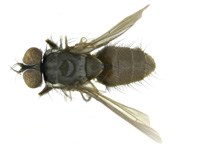Abstract
Three species that belong to the genus Epicauta (Coleopera: Meloidae), E. chinensis, E. dubia, and E. sibirica, appear morphologically indistinguishable. The present study aims to resolve the taxonomic status and the relationships among these three species. Identifying adult morphological characters among the three species were compared and illustrated and partial fragments of the mitochondrial gene (COI) for 77 samples, representing seven meloid species, were obtained and analyzed. Analyses of nucleotide composition, genetic distances and phylogenetics were performed. The results of the morphological studies and molecular analyses showed concordance, indicating that the three species are closely related and indistinguishable from one another. Consequently, two new synonyms are proposed: E. chinensis (Laporte, 1840) syn. n. = E. sibirica (Pallas, 1773) and E. dubia (Fabricius, 1781) syn. n. = E. sibirica (Pallas, 1773).
References
Bologna, M.A. (1991) Coleoptera Meloidae. Fauna d'Italia. XXVIII. Calderini, Bologna.
Bologna, M.A. & Pinto, J.D. (2001) Phylogenetic studies of Meloidae (Coleoptera), with emphasis on the evolution of phoresy. Systematic Entomology, 26, 33–72.
http://dx.doi.org/10.1046/j.1365-3113.2001.00132.xBologna, M.A. & Pinto, J.D. (2002) The Old World genera of Meloidae (Coleoptera): a key and synopsis. Journal of Natural History, 36, 2013–2102.
http://dx.doi.org/10.1080/00222930110062318Bologna, M.A., Turco, F. & Pinto, J.D. (2010) Arthropoda: Insecta. 11.19. Meloidae Gyllenhal, 1810. In: Leschen, R.A.B., Beutel, R.G. & Lawrence, J.F. (Vol. Eds.), Kristensen, N.P. & Beutel, R.G. (Ed.), Handbook of Zoology. Coleoptera, Beetles. Vol. 2. Morphology and Systematics (Elateroidea, Bostrichiformia, Cucujiformia partim). Walter de Gruyter GmbH & Co. KG, Berlin/New York, pp. 681–693.
Felsenstein, J. (1981) Evolutionary trees from DNA sequences: a maximum likelihood approach. Journal of Molecular Evolution, 17, 368–376.
http://dx.doi.org/10.1007/BF01734359Folmer, O., Black, M., Hoeh, W., Lutz, R. & Vrijenhoek, R. (1994) DNA primers for amplification of mitochondrial cytochrome c oxidase subunit I from diverse metazoan invertebrates. Molecular Marine Biology and Biotechnology, 3, 294–299.
Hall, T.A. (1999) BioEdit: a user-friendly biological sequence alignment editor and analysis program for Windows 95/98/NT. Nucleic Acids Symposium Series, 41, 95–98.
Hajibabaei, M., Singer, G.A.C., Hebert, P.D.N. & Hickey, D.A. (2007) DNA barcoding: how it complements taxonomy, molecular phylogenetics and population genetics. Trends in Genetics, 23, 167–172.
http://dx.doi.org/10.1016/j.tig.2007.02.001Hasegawa, M., Yano, T. & Kishino, H. (1984) A new molecular clock of mitochondrial DNA and the evolution of hominoids. Proceeding of the Japan Academy Series B: Physical and Biological Sciences, 60, 95–98.
http://dx.doi.org/10.2183/pjab.60.95Hebert, P.D.N., Cywinska, A., Ball, S.L. & deWaard, J.R. (2003a) Biological identifications through DNA barcodes. Proceedings of the Royal Society of London, Series B: Biological Sciences, 270, 313–321.
http://dx.doi.org/10.1098/rspb.2002.2218Hebert, P.D.N., Ratnasingham, S. & deWaard, J.R. (2003b) Barcoding animal life: cytochrome c oxidase subunit I divergences among closely related species. Proceedings of the Royal Society of London, Series B: Biological Sciences, 270 (Supplement 1), S96–S99.
http://dx.doi.org/10.1098/rsbl.2003.0025Huelsenbeck, J.P. & Ronquist, F. (2001) MRBAYES: Bayesian inference of phylogenetic trees. Bioinformatics, 17, 754–755.
http://dx.doi.org/10.1093/bioinformatics/17.8.754Jobb, G. (2011) TREEFINDER version of March 2011. Munich, Germany.
Jukes, T. & Cantor, C. (1969) Evolution of protein molecules. In: Munro, H.N. (Ed.), Mammalian Protein Metabolism. Academic Press, New York, pp. 21–132.
Kaszab, Z. (1952) Die paläarktischen und orientalischen Arten der Meloiden-Gattung Epicauta Redtb. Acta biologica Academiae Scientiarum Hungaricae, 3, 573–599.
Kaszab, Z. (1953) Revision der aethiopischen Arten der Meloiden-Gattung Epicauta Redtb. Acta Biologica Academiae Scientiarum Hungaricae, 4, 481–513.
Kaszab, Z. (1960) Einige neue Meloiden (Coleoptera) des Museums G. Frey. Entomologische Arbeiten aus dem Museum G. Frey, 11, 283–290.
Kaszab, Z. (1978) Neue Meloiden aus Asien, Afrika uns Südamerika (Coleoptera). Acta Zoologica Academiae Scientiarum Hungaricae, 24, 331–342.
Massimino Cocuzza, G.E. & Cavalieri, V. (2014) Identification of aphids of Aphis frangulae-group living on Lamiaceae species through DNA barcode. Molecular Ecology Resources, 14, 447–457.
http://dx.doi.org/10.1111/1755-0998.12199Nei, M. & Kumar, S. (2000) Molecular evolution and phylogenetics. Oxford University Press, Oxford.
Park, D.S., Foottit, R., Maw, E. & Hebert, P.D.N. (2011) Barcoding Bugs: DNA-based identification of the true bugs (Insecta: Hemiptera: Heteroptera). PLoS One, 6, e18749.
http://dx.doi.org/10.1371/journal.pone.0018749Pinto, J.D. (1991) Taxonomy of North American Epicauta (Coleoptera: Meloidae), with a revision of the nominate subgenus and a survey of courtship behavior. University of California Publications in Entomology, 110, i–ix, 1–372, 40 pls.
Pinto, J.D. & Bologna, M.A. (1999) The New World genera of Meloidae (Coleoptera): a key and synopsis. Journal of Natural History, 33, 569–620.
http://dx.doi.org/10.1080/002229399300254Posada, D. (2008) jModelTest: Phylogenetic model averaging. Molecular Biology and Evolution, 25, 1253–1256.
http://dx.doi.org/10.1093/molbev/msn083Rambaut, A. (2012) Figtree v1.4.0. Available from http://tree.bio.ed.ac.uk/software/ figtree/(accessed October 2014)
Rambaut, A. & Drummond, A.J. (2007) Tracer v1.4. Available from http://tree.bio.ed.ac.uk/software/tracer/(accessed October 2014)
Ronquist, F. & Huelsenbeck, J.P. (2003) MrBayes 3: Bayesian phylogenetic inference under mixed models. Bioinformatics, 19, 1272–1274.
http://dx.doi.org/10.1093/bioinformatics/btg180Schindel, D.E. & Miller, S.E. (2005) DNA barcoding a useful tool for taxonomists. Nature, 435, 17.
http://dx.doi.org/10.1038/435017bSelander, R.B. (1981) Evidence for a third type of larval prey in blister beetles (Coleoptera: Meloidae). Journal of the Kansas Entomological Society, 54, 757–783.
Selander, R.B. (1982) Further studies of predation on meloid egg by meloid larvae (Coleoptera). Journal of the Kansas Entomological Society, 55, 427–441.
Strimmer, K. & Rambaut, A. (2002) Inferring confidence sets of possibly misspecified gene trees. Proceedings of the Royal Society B-Biological Sciences, 269, 137–142.
http://dx.doi.org/10.1098/rspb.2001.1862Tamura, K. & Nei, M. (1993) Estimation of the number of nucleotide substitutions in the control region of mitochondrial DNA in humans and chimpanzees. Molecular Biology and Evolution, 10, 512–526.
Tamura, K., Peterson, D., Peterson, N., Stecher, G., Nei, M. & Kumar, S. (2011) MEGA5: Molecular evolutionary genetics analysis using Maximum Likelihood, Evolutionary Distance, and Maximum Parsimony methods. Molecular Biology and Evolution, 28, 2731–2739.
http://dx.doi.org/10.1093/molbev/msr121Tan, J.J. (1958) On the genus Epicauta Redtb. of China (Meloidae, Coleoptera). Acta Entomologica Sinica, 8, 152–167. [in Chinese with English summary]
Tscherenyshev, S.E. (1996) Blister beetles (Coleoptera, Meloidae) of Mongolia. Russian Entomological Journal, 5, 49–57.
Wang, X.P., Pan, Z. & Ren, G.D. (2010) The Chinese genera of Meloidae (Coleoptera: Tenebrionoidea). Entomotaxonomia, 32 (Supplement), 43–52.
Yang, Y.X. & Ren, G.D. (2007) A taxonomic study on Epicauta tibialis group from China (Coleoptera, Meloidae). Acta Zootaxonomica Sinica, 32, 711–715. [in Chinese with English summary].

